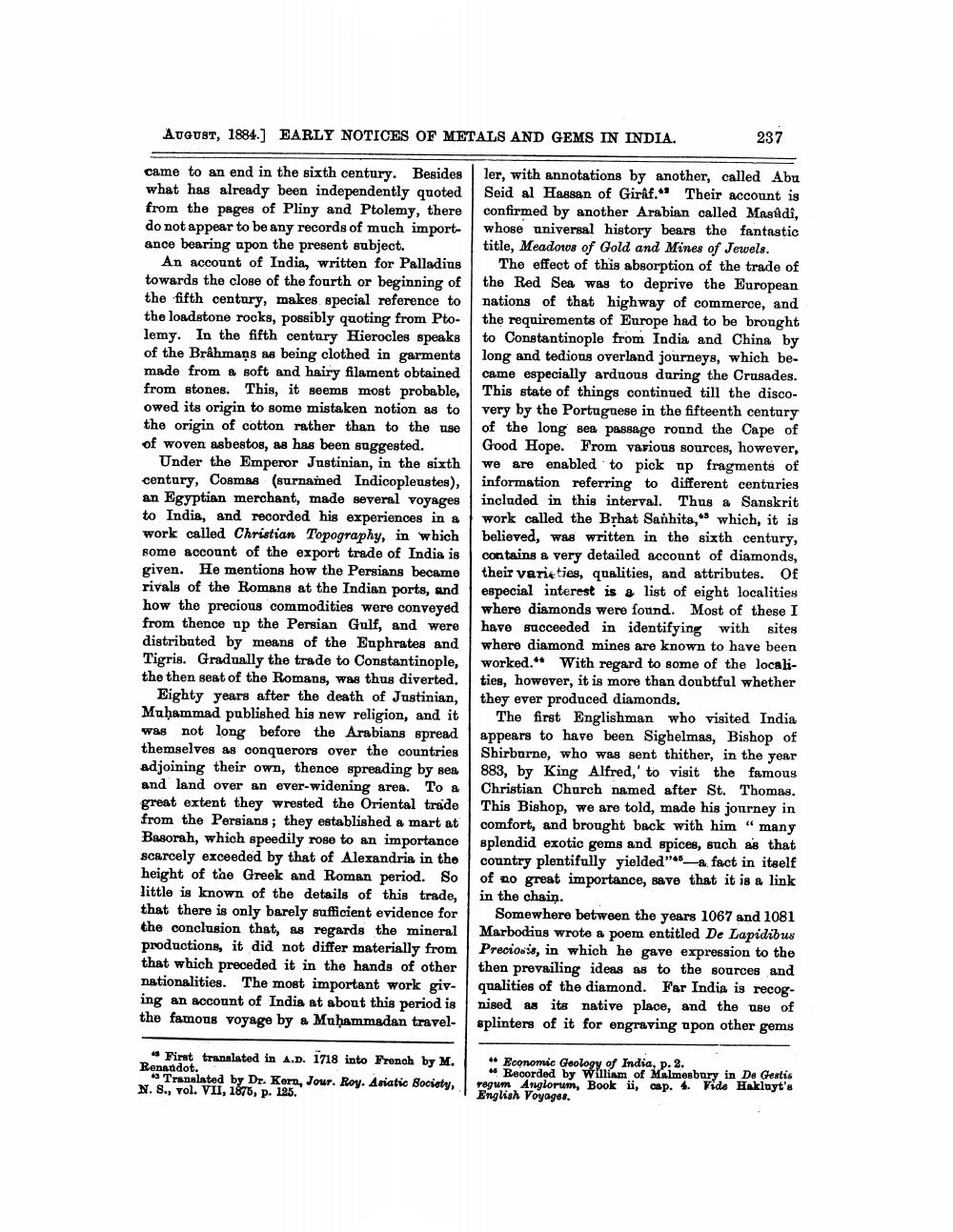________________
AUGUST, 1884.] EARLY NOTICES OF METALS AND GEMS IN INDIA.
237
came to an end in the sixth century. Besides what has already been independently quoted from the pages of Pliny and Ptolemy, there do not appear to be any records of much importance bearing upon the present subject.
An account of India, written for Palladius towards the close of the fourth or beginning of the fifth century, makes special reference to the loadstone rocks, possibly quoting from Ptolemy. In the fifth century Hierocles speaks of the Brahmans as being clothed in garments made from a soft and hairy filament obtained from stones. This, it seems most probable, owed its origin to some mistaken notion as to the origin of cotton rather than to the use of woven asbestos, as has been suggested.
Under the Emperor Justinian, in the sixth century, Cosmas (surnamed Indicopleustes), an Egyptian merchant, made several voyages to India, and recorded his experiences in a work called Christian Topography, in which some account of the export trade of India is given. He mentions how the Persians became rivals of the Romans at the Indian ports, and how the precious commodities were conveyed from thence up the Persian Gulf, and were distributed by means of the Euphrates and Tigris. Gradually the trade to Constantinople, the then seat of the Romans, was thus diverted.
Eighty years after the death of Justinian, Muhammad published his new religion, and it was not long before the Arabians spread themselves as conquerors over the countries adjoining their own, thence spreading by sea and land over an ever-widening area. To a great extent they wrested the Oriental trade from the Persians; they established a mart at Basorah, which speedily rose to an importance scarcely exceeded by that of Alexandria in the height of the Greek and Roman period. So little is known of the details of this trade, that there is only barely sufficient evidence for the conclusion that, as regards the mineral productions, it did not differ materially from that which preceded it in the hands of other nationalities. The most important work giving an account of India at about this period is the famous voyage by a Muhammadan travel
ler, with annotations by another, called Abu Seid al Hassan of Giraf." Their account is confirmed by another Arabian called Masudi, whose universal history bears the fantastic title, Meadows of Gold and Mines of Jewels.
The effect of this absorption of the trade of the Red Sea was to deprive the European nations of that highway of commerce, and the requirements of Europe had to be brought to Constantinople from India and China by long and tedions overland journeys, which became especially arduous during the Crusades. This state of things continued till the discovery by the Portuguese in the fifteenth century of the long sea passage round the Cape of Good Hope. From various sources, however, we are enabled to pick up fragments of information referring to different centuries included in this interval. Thus & Sanskrit work called the Brhat Sanhita," which, it is believed, was written in the sixth century, contains a very detailed account of diamonds, their varieties, qualities, and attributes. Of especial interest is a list of eight localities where diamonds were found. Most of these I have succeeded in identifying with sites where diamond mines are known to have been worked." With regard to some of the localities, however, it is more than doubtful whether they ever produced diamonds.
The first Englishman who visited India appears to have been Sighelmas, Bishop of Shirborne, who was sent thither, in the year 883, by King Alfred,' to visit the famous Christian Church named after St. Thomas. This Bishop, we are told, made his journey in comfort, and brought back with him " many splendid exotic gems and spices, such as that country plentifully yielded" -a fact in itself of no great importance, save that it is a link in the chain.
Somewhere between the years 1067 and 1081 Marbodius wrote a poem entitled De Lapidibus Preciosis, in which he gave expression to the then prevailing ideas as to the sources and qualities of the diamond. Far India is recognised as its native place, and the use of splinters of it for engraving upon other gems
"First translated in A.D. 1718 into French by M. Renaadot.
"Translated by Dr. Kern, Jour. Roy. Asiatic Society, N. S., vol. VII, 1876, p. 125.
* Economic Geology of India, p. 2.
* Recorded by William of Malmesbury in De Gestis regum Anglorum, Book ii, cap. 4. Vide Hakluyt's English Voyages.




